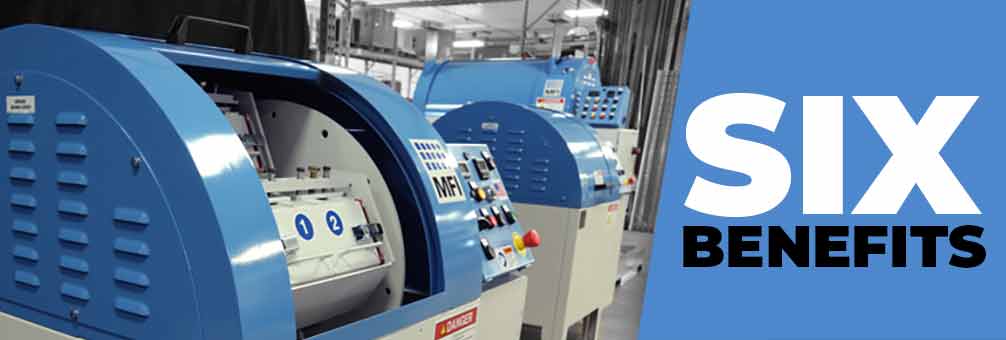Centrifugal barrel finishing is a mass finishing process that involves the use of a rotating barrel or drum filled with media, parts, and a finishing compound. The barrel is spun at high speeds, creating centrifugal force that causes the contents to slide and tumble within the barrel, resulting in a highly efficient and effective finishing process. Overall, this process enhances productivity, reduces manual labor requirements, and delivers consistent, high-quality results, optimizing the manufacturing workflow.
Centrifugal Barrel Finishing Benefits
There are several key benefits of centrifugal barrel finishing for manufacturers. We’re going to discuss some of the main advantages to highlight how this surface finishing technique can not only significantly improve production processes, but also product quality.
1. Uniform and Consistent Finishing
With centrifugal barrel finishing, all parts within the barrel are subjected to the same forces and movements. The result is consistent and uniform finishing results across all workpieces, eliminating variations and ensuring a high-quality surface finish.
2. Shorter Processing Times
Centrifugal barrel finishing offers significantly shorter processing times compared to other surface finishing techniques, such as vibratory finishing. The high rotational speed of the barrel generates intense centrifugal forces, enabling more efficient material removal, deburring, and edge radiusing on parts. The result is that manufacturers can achieve their desired finishing results in much shorter processing times compared to other processing techniques.
This form of finishing is also known as a type of batch processing, meaning manufacturers are able to process multiple parts simultaneously (depending on the part size) – which boosts productivity and throughput.
3. Quieter Operation
Unlike many other mass finishing processes, centrifugal barrel finishing operates at lower noise levels. The reduced noise makes it an ideal choice for creating a more comfortable working environment for employees. The quieter operation also allows the machines to be installed in sensitive areas of the production floor, where excessive noise or vibration might affect the precision of other manufacturing processes.
4. Versatility
This finishing method is suitable for a wide range of part shapes, sizes, and materials. Whether it’s small intricate components like Swiss parts, or larger workpieces, centrifugal barrel finishing can accommodate various geometries and materials making it a versatile option for manufacturers in a variety of industries.
5. Improved Surface Quality
The tumbling action of the media and parts within the barrel, coupled with the high rotational speeds, contribute to improved surface quality. Centrifugal barrel finishing can effectively remove burrs, sharp edges, and surface imperfections, resulting in smoother and more refined surfaces. The tumbling action of the media and parts in the barrel helps in leveling, polishing, and burnishing the surfaces, enhancing their appearance and functionality.
6. Cost-effectiveness
Centrifugal barrel finishing presents a cost-effective alternative to manual or hand-finishing processes. By eliminating labor-intensive and time-consuming manual operations, it minimizes the risk of human errors and enhances overall process efficiency. Additionally, the reusable nature of the media used in the process further contributes to cost-effectiveness.
Types of Materials
Now that we have explored some of the benefits of centrifugal barrel finishing, let’s dive into some of the materials that can be processed using this method. Centrifugal barrel finishing machines can process a wide range of materials, including metals, plastics, ceramics, and composites. The process is versatile and suitable for various types of parts. Here are some examples of materials commonly processed in centrifugal barrel finishing:
Metals: Centrifugal barrel finishing is frequently used for metal parts, such as steel, stainless steel, aluminum, brass, copper, and titanium. It can effectively remove burrs, polish surfaces, and enhance the overall finish of these materials.
Plastics: Many types of plastics can be processed using centrifugal barrel finishing, including ABS, polycarbonate, polypropylene, polyethylene, and acrylics. The process can be used to remove flash, improve surface smoothness, and achieve a polished appearance.
Ceramics: Centrifugal barrel finishing is suitable for ceramic materials, including alumina, zirconia, and silicon nitride. It can be used to remove excess material, refine surfaces, and improve the dimensional accuracy of ceramic components.
Composites: Centrifugal barrel finishing can process composite materials, such as fiberglass-reinforced plastics (FRP) or carbon fiber-reinforced polymers (CFRP). It can help remove excess resin, smooth out surfaces, and enhance the appearance and performance of composite parts.
Other Materials: In addition to the above, centrifugal barrel finishing can be applied to other materials like glass, rubber, and certain types of wood. The specific requirements and considerations may vary depending on the characteristics and properties of the material.
It’s important to note that the selection of media and finishing compounds should be tailored to the material being processed to ensure optimal results. Different materials may require specific media types (e.g., ceramic, plastic, or steel media) and appropriate compounds to achieve the desired surface finish and avoid damage to the parts.
Conclusion
In summary, centrifugal barrel finishing provides a range of compelling benefits for manufacturers. It ensures consistent and uniform finishing results, reduces processing times, operates quietly, accommodates various part shapes and materials, improves surface quality, and offers cost-effectiveness. Additionally, the versatility of this surface finishing technique allows for widespread adoption across different industries, helping manufacturers meet their production goals and deliver high-quality products to their customers.

